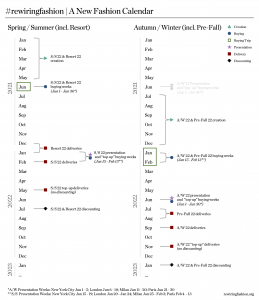#rewiringfashion is a product of ongoing conversations between a growing group of independent designers, CEOs and retail executives from around the world who have come together to rethink how the fashion industry could - and should, work.
It's time to slow down and rediscover the storytelling and magic of fashion. It's time to move away from a fashion system that stunts creativity in favour of profits and serves no interests to designers, retailers nor consumers.
The #rewiringfashion movement is facilitated by The Business of Fashion and is backed with a numerous amount of members within the fashion industry.
The three practical issues highlighted in this movement are:
- A fashion calendar that is out of sync with the end customer, unsustainable for industry professionals and damaging for sales.
- A fashion show format that is outmoded.
- An addiction to discounts that train shoppers to expect perennial markdowns, eroding profitability and brand equity for everyone along the value chain.
Resetting the fashion calendar
The problem with the current fashion calendar is the fact that shows are staged too far ahead of product deliveries - thus the desire for a garment after a show is long gone when it finally is hitting retailers.
This "lag" from show to retailers means that many copycat fast-fashion brands are able to produce garments that are cheaper (facilitating the fast-fashion industry) but also of worse quality (which affects the end consumer).
The delivery dates are out of sync with real-world seasons.
Discounts and sales are far too prominent in the fashion industry and as mentioned, it does not benefit anyone within the value chain. The amount of time a piece or collection is actually sold for their full price are far too short.
Buyers and press expend too much time, money and energy travelling.
How can we fix this?
Combine men's and women's fashion weeks to take place in Jan/Feb and June to enable a longer full-price selling period. This will also minimise travel expenses and time for both press and buyers as going to one show will offer a bigger variety of choice.
Align these shows with "real-world" seasons, just as it is about to hit fall so weather-appropriate clothing can be sold at stores as soon as it is shown.
We can also synchronise next season buying periods with current season presentations to cut back on travel.
Fashion shows - reimagined
The format of fashion shows has remained the same for fifty years, the only thing that has changed is the type of people invited to them. These events use to be exclusive viewings for press and buyers. Now, filled with celebrities and influencers. Though this isn't necessarily a bad thing - the fashion shows need to change to adapt to this new audience.
What if we...
Fashions shows should be designed to engage customers and exposure for deliveries that are expected to arrive in store soon after the shows.
No rules should be imposed by convention or fashion councils regarding the format of shows - these should be up to the designers so they can create shows that best engage their unique customers.
Moreover, the expectation for designers to show every season should be abolished.
Break the addiction to discounting
Large amounts of last season products are unsold, thus giving retailers no choice but the discount the products to clear their inventory. However, retailers have often turn early to discounting their products to drive traffic and sales making it now a normal expectation for customers to have when buying clothes.
So...
Retailers should avoid extreme discounting for last season's stock - you have to keep in mind the long-term benefit and importance of brand equity and profitability. Unsold stock does not mean a garment is any less valuable than it was a month ago.
We should stop in-season discounting - no more, Black Friday, Cyber Monday, Valentine's Specials etc.
This is the message that the collective behind #rewiringfashion believes, and we think it outlines the actions the fashion industry must think long and hard about.
Something needs to change, actions must be taken to preserve the beauty, creativity and craft of the fashion industry while building solid and sustainable businesses that can survive storms such as COVID-19 and beyond.
If you are a designer or a retailer and would like to support #rewiringfashion, you can join by clicking here.









